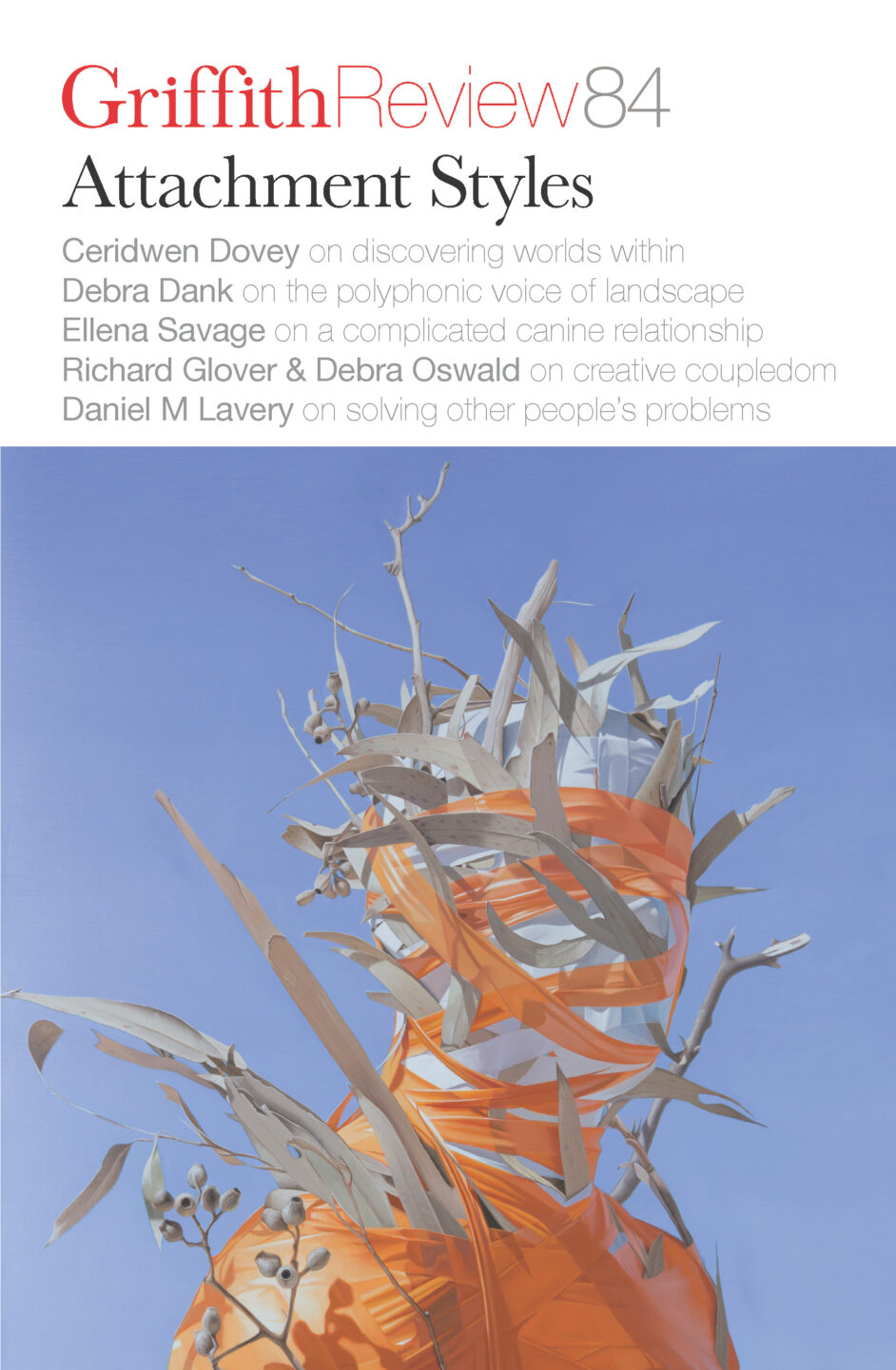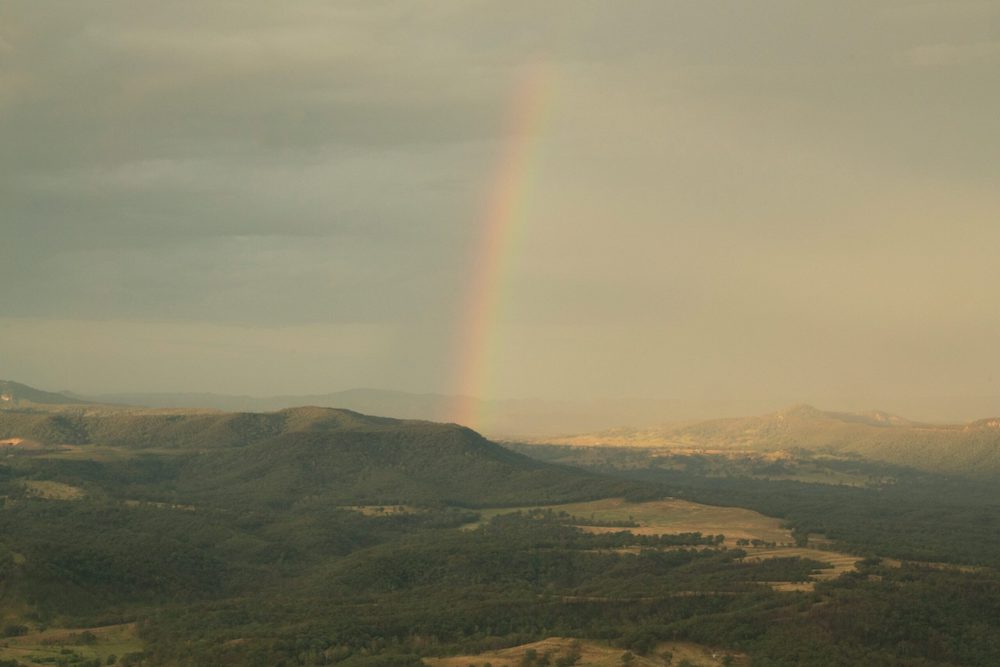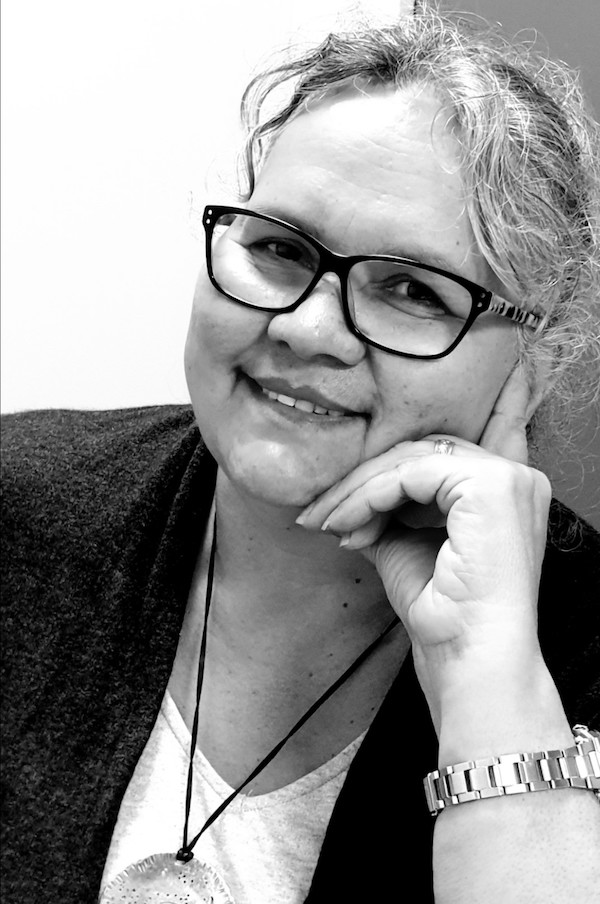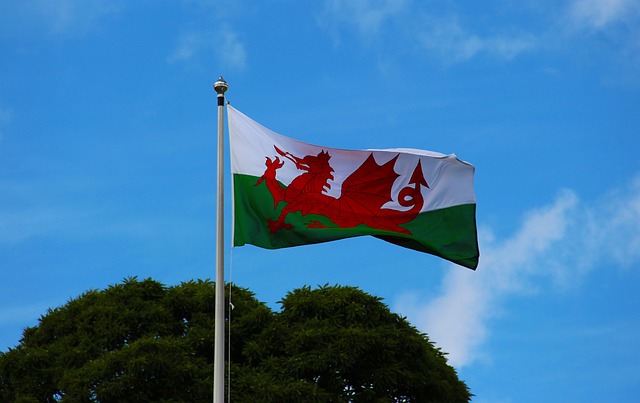Past-making within the present
Speaking the voice of community
Featured in

- Published 20240507
- ISBN: 978-1-922212-95-5
- Extent: 203pp
- Paperback, ePub, PDF, Kindle compatible

Debra Dank wasn’t planning to write a book. But in 2022, her PhD in narrative theory and semiotics was published as We Come with This Place, a lyrical and richly evocative account of Country, family and ancestors. What began as an academic project – one that Dank imagined only her children would read – went on to captivate audiences across the nation and collect a slew of top literary prizes.
It’s easy to see why. Dank is a Gudanji/Wakaja woman, an experienced educator, a partner, a mother and a grandmother – and while all these life experiences are present in her book, its narrative threads stretch much further. We Come with This Place weaves together a multiplicity of voices, entities and stories, all of which reflect the collectivism of Aboriginal culture. In this interview, which has been lightly edited and condensed for clarity, Dank talks to Griffith Review Editor Carody Culver about the strength of community, the solace of stories and the ever-present salience of the past.
CARODY CULVER: Your relationship with reading seems to be an integral aspect of who you are as a person, and you write in We Come with This Place about how you’ve loved books since you were a child. When did this love of books begin?
DEBRA DANK: Growing up, that idea of reading…was filtered through this need to be critically and highly aware of our environment, so reading has always had a very wide connotation for me. As a Gudanji person, I wake up in the morning, I look at the environment, I’m reading the environment to see, okay, what’s going on today? I’m sitting or walking by the river, I’m looking carefully at what’s going on and how the river is looking. I’m reading the river to see where I’m most likely to catch a fish.
Books came into my life [when I was] quite a young child, and my mum was an avid reader. I’ve not known a home without books or a swag without books…[they] were simply an extended practice or exercise, and quite a specific exercise, in reading. I think the idea of confining the notion of reading to books kind of takes us away from the deeper awareness of our relationship with the wider environment and all the other entities there.
CC: I love that expansive way of thinking about reading – it opens you up, as you say, to your own environment, reading what’s around you and developing a greater understanding of the context in which you exist. And then reading a book is a way to enter other worlds and develop an understanding of things far beyond the place where you live.
DD: And that’s what books specifically gave me. As a child I was quite isolated, and I’ve always been really curious, so books gave me the opportunity to feed that curiosity. I just worry that too many people are no longer understanding how amazingly big the gift of a book is to one’s self.
CC: It also comes down to that idea of attention, doesn’t it – being able to give your attention to a book, to the world around you, and being able to think about or focus on that one thing for an extended period.
DD: Absolutely. I read some research very recently suggesting…that learning is so much more constructive and real when children engage with paper rather than devices and the online learning experience. Absolutely there’s a place for that [online experience] in classrooms – I’m a teacher in my normal life – but…we are running so quickly towards a digital space. I downloaded an ebook recently and I was like, Debra, you’re going to the dark side – stop!
CC: It’s such a different experience, though, when you don’t have that physical object.
DD: The smell is gone. The texture is gone, all of that. The physical connection is gone and replaced by a distancing and separation. And I think that’s one of the things that means so much to me with the reading of a physical book…it reflects my values and the way I was reared as an Aboriginal person because there’s that reciprocity, there’s the obligation, there’s the responsibility to be respectful around engaging with the entirety of the book – not just the narrative, not just the characters, but the entire book.
CC: Your mum taught you to read, and there’s a beautiful line in your book where you say that your dad didn’t read or write English but ‘read stories in a landscape that was full of them’. Could you tell me how your parents shaped your relationship with stories – not just stories in books, but stories of Country and of your ancestors?
DD: It just seemed that everything evolved around knowing the right stories. Because if you knew the right stories then you were prepared to journey to the next part of your life. When I went to teachers’ college, right at the very beginning we were told that a researcher by the name of Bandura was talking about an internal and external locus of control. According to Bandura, Western cultures had an internal locus of control, and within the context of my teacher-education training, we were told that children from Western cultures had the ability to make decisions/choices for themselves. They had the ability to say, ‘When I grow up, I want to be this’ or ‘I want to do that’, irrespective of the needs of community or family – just what the child wanted. We were told we had to really work hard…to build that ability within Aboriginal children particularly, because Aboriginal children have an external locus of control: they make decisions according to the community, what the community needs, what the community desires, what’s best for the community and not about individual wants. I really, really worried about that because we do not live individually, and when one is motivated solely by individuality and individual desires and individual aspirations, there’s something that is lost around the sense of community. I think we can see that easily if we just think about our current context. But for Aboriginal children to have been told that that was wrong is wicked on many levels. Aboriginal children are still being told, ‘No, you have to make decisions for you.’
It doesn’t work like that. Understanding those stories of the ancestors, the stories of your grandparents, the stories of extended family, builds that context around community and it gives you the opportunity to see yourself within that wider community – not as an individual but as somebody who has responsibility for those around them. And when you do that, you have a greater sense of awareness around what resources you use. You have a greater sense of not taking more than you need. You have a greater sense of taking care of others, including our non-human kin. So, those stories that I grew up with were about teaching me to be a good community member rather than being a good individual. Through those stories that my father told me, I knew that I needed to take care of the physical environment because if I didn’t, I wasn’t going to have food. If I didn’t use those resources wisely, I was going to have to take them off somebody else who needed them and had as much right to them as I did. Reading as widely as we did/do, as Gudanji, was genuinely about living a good and proper life.
CC: Your career in education is what led you to write We Come with This Place – the book began as a PhD project, and that PhD explored polyphony in narrative styles. I’m really interested in hearing more about that and about the role polyphony plays in Gudanji storytelling.
DD: I’ve always wondered: why are we defined through Western notions and Western ideas?… English is 1,500 years old as a language. [Aboriginal people] have been here on this continent for at least 65,000 years, according to Western society, [and] our languages, the oral traditions and practices within our languages maintain validity for…between 13,000 and 15,000 years. So the validity or ability of our oral traditions to retain truth is significantly older than the English language itself. The assumption that the English language has the capacity to articulate Aboriginal experience and Aboriginal lived experience and Aboriginal deep theoretical ideas has no logic to it at all. I got to thinking about all of those sorts of things, and then I thought…we’re always talking about our relationship with Country and the connection that we have to Country and our ability and our need to listen to the stories and to live with those stories. And as I said before, if I go for a walk along the river and I’m looking for the best place to catch a fish…I’m looking at a whole range of other signs and a whole range of other entities, non-human entities, and how they are engaging with the river: if there are birds at a particular spot, a particular kind of bird, if the water is behaving in a particular way. Those sorts of things are all considered by Aboriginal people to be some of the voices that narrate particular stories. And that is what polyphony means: the multiplicity of voices. Being on Country and [being able] to understand and to maintain and to operate through the connection we have with Country is about understanding the presence, but also the content, of those other voices that are not necessarily human and to learn through them.
CC: That’s fascinating, and it partly answers my next question, which was about the fact that in Western culture we seem quite attached to this idea of sole authorship – but there’s obviously so much that we miss out on by thinking in those limited terms, isn’t there?
DD: Absolutely… The wonderful thing about being part of an Aboriginal culture is the notion of collectivism. I don’t ever have to be lonely or alone if I choose not to be. And as an introvert, sometimes [I find that] frustrating – but I know that my children are not ever going to be without the important things because they are part of this amazing Aboriginal family. I can see that they struggle a little bit with [this Western sense of individualism] – they’re always…conscious of how what they do will impact others. We can’t and we don’t live alone, so we shouldn’t imagine that it’s possible to be solo in anything, really. Although I’ve only got one aunt left now with full language and old cultural tradition, my children benefited [from] the privilege of growing up in that context and growing up with their Elders, learning all of those old ways that make sense in a deeply human way. It makes it easy to understand the connections and entanglements of people, place and kin. They see their way into a future that has absolutely grown from the past.
CC: And the book really captures that sense of the past always being present. There are several parts of We Come with This Place where you’re reimagining events that, as you put it, happened outside your presence – did those stories take on different shapes or meanings when you wrote them down?
DD: The Marranbarna Dreaming story is a central story to Gudanji, and that essential story forms our beingness. My kids grew up hearing that story from when they were tiny babies – they heard it through my words and they heard it through the words of their grannies, so they could embed the story within their own sense of identity and then retell it. Both of my girls are mums now, and they retell that story to their daughters all the time, so it just becomes a normal part of who and how they are as Gudanji people. We do retell those stories in our own way, but we tell them in [a] way that includes the contemporariness of the current context – it becomes a bit about time and a bit about the location of that story right now, but it’s always about evoking the past, because we’re always past-making within that present. With [reimagining] things that have happened in the past, there are particular mnemonics, if you like, that maintain the standards and maintain the truth… The mnemonics are connected to the geographic landscape, so again [this is] why the connection to Country is so important for Aboriginal people. Why our ability to live on Country is so important. The reimagining is about me being able to build my relationship into that story in a way that [allows me to] sustain it so that it continues, to ensure the story will always have particular truths that are embedded within Country.
CC: I wanted to ask you specifically about your connection to Country, because your book is as much about place as it is about family. You’re from the Northern Territory, towards the Gulf of Carpentaria, but you grew up in far west Queensland, in Camooweal, and you evoke the landscape so vividly in your writing. Are there particular feelings that each of these places evokes for you when you go back there?
DD: My Country stretches from the border near Camooweal to the Gulf Country, across big spaces on the Barkly Tableland. I can breathe when I am back there, and it’s a really strange thing – my kids say the same now… I’ve got a thirty-eight-year-old, a thirty-two-year-old and a thirty-year-old, and they all now say exactly the same: ‘It’s just so good to be home. Now we can breathe.’ And it’s not that we’re stressed when we’re…away from home. I think the privilege of not being a singular entity within the Aboriginal community is that you do have this shared sense of living and relationship across the greater community inclusive of Country, so when we go home it’s an entirely other experience, because we live with Country and we are dependent on that relationship.
When my children were small, the old people were always saying ‘Don’t walk hard, don’t walk hard, walk soft here.’ And we have a 120, 130-year-old house, and it’s all wobbly and everything creaks, but you can never hear my kids walking around it [when they’re here]. It truly is a different way of placing your feet. We always hear [my husband] Rick because he’s thump, thump, thump. And I say to him all the time, ‘Can you stop walking so hard?’ but he just can’t – people in the West are told all the time to walk firmly. You can walk firmly without thump, thump, thump! When we’re home, if we walk around and make lots of noises, then we’re waking up parts of the Country that need to sleep. We’re waking up parts of our non-human kin who shouldn’t be woken up. We are causing disturbances that we do not have the right to cause. So walking softly – not creeping, walking softly – is the way that we instinctively walk when we’re at home.
CC: Your book is often described as a memoir, but do you think of it in those terms?
DD: The idea of memoir goes back to that singularity, it goes back to individualism. This book is so far from a memoir, and it’s kind of like what I just said about my role maintaining those stories – it’s a reflection of the stories and how I am currently responsible for them. How I make choices about what the important stories are for my children to know so that they have the ability to join the dots and be a cohesive part of that wider Gudanji community.
It’s really interesting because we can read the words within We Come with This Place and they will give you one story. But Gudanji people, of course, will read the words and have completely different understandings and ideas. That goes to the idea of polysemy, and a good example of polysemy is if I talk about the idea of home. For me, home is Country up there across the Barkly Tableland and Gulf Country. For Western people, home is typically a house, you know, a built structure. And so when Aboriginal people are talking about home, we are always imagining Country. The problem, the complexity, is when it comes to policymaking and such. In situations where consultation occurs, Aboriginal people will be talking about home, [but] the person collecting the data is often someone who is monolingual, who speaks English as their first language, and so their understanding of what constitutes home is really quite different…that’s one of the issues when we kind of assume it’s okay for Aboriginal lived experience to be articulated through English language without understanding that bigger semiotic context.
CC: And in that bigger context, the book has many moments of joy – I love the story of when you brought Rick home to meet your parents for the very first time. But there’s also darkness, there’s trauma, there’s the constant threat of children being removed from their parents, there are the deep scars of colonisation. Why was it important to you to include all of those stories – the hard ones as well as the beautiful ones?
DD: It’s got to be truth. We don’t ever get to live an untarnished and non-traumatic life – nobody, none of us, and I think sometimes when we don’t embrace the bigger context around trauma, around horror and tragedy, that causes us more problems in the end. We all need to understand how we can cope with the outrage of loss because none of us get to escape it… I think it’s one of the [aspects of] the human condition that we don’t want to admit is normal. But [we] often lack [the] ability to understand the fullness of it and to have those really big, deep conversations. It frustrates me to hear the number of times that word ‘resilience’ is used. To appreciate the sublime, we have to live through the outrage to make our lives less than absurd.
CC: I’ve read a couple of other interviews with you where you’ve said that even though both of your parents have passed away, you can’t talk about them in the past tense. I was struck by that – is it a conscious choice on your part, or is it something you find yourself doing reflexively?
DD: I’m the product of my parents, so again, it’s a strange kind of individualistic thinking to imagine that I am not just the current form of, the combination of, my parents. They can’t go, they’re not gone, they just have a different form. Sometimes in my head I struggle to find the difference between me and my mother, because my daughters and my son often say now, ‘You sound just like Nan’, and they don’t always mean it in a good way! But I think again it’s part of that internal/external locus of control, it’s part of being in a community, it’s part of honouring the past, it’s part of respecting the ancestors. I will get my turn at being honoured in that way by my children and my grandchildren… It’s how we think as Aboriginal people, as Gudanji people, and it’s why we walk soft on the earth. We all live through an entangled life with Country and kin through the stories. Our responsibility is to ensure the stories all continue to live in ways that show that respect. It’s why we remember the stories and retell the stories. [My parents’] physical bodies are gone, but ultimately they have created new physical bodies, just like the grandparents and the great-grandparents and other ancestors have done for thousands and thousands of years.
Photo credit: Nerissa J from Unsplash
Share article
About the author

Debra Dank
Debra Dank is a Gudanji/Wakaja woman whose book, We Come with This Place (Echo Publishing, 2022), won four NSW Premier’s Literary Awards in 2023:...
More from this edition

Land of my fathers
Non-fictionOn Saturday mornings his friends would call in to pick him up for the game. Like him, they were broad and tall and humorous, and never still. None of them ever seemed comfortable indoors. Their faces were fevered from sitting in winter stadiums. Even as septuagenarians they continued to refer to themselves as ‘the boys’, and if my mother materialised before them, they’d blush like children.

It’s only natural
Non-fictionI often feel that we have landed in the worst of all possible worlds for women when it comes to breastfeeding. We are subject to an ideology that argues for its singular efficacy in generating infant attachment to the mother, making an inviolable and exclusive bond. We are also expected to breastfeed to repudiate the maternal industrial complex that fills our supermarkets with formula in shiny tins.

Seized by a ceaseless meanwhile
Non-fictionOwing to its prominent location and spectacular collapse, Álvaro Obregón 286 featured prominently in media coverage of the earthquake rescue. But residents told me they always suspected something was afoot. Within twenty-four hours of the disaster, rescuers from Israel and Spain arrived onsite. Both teams quickly recovered documents and computers and rescued only specific people, while others in the rubble still cried out for help.